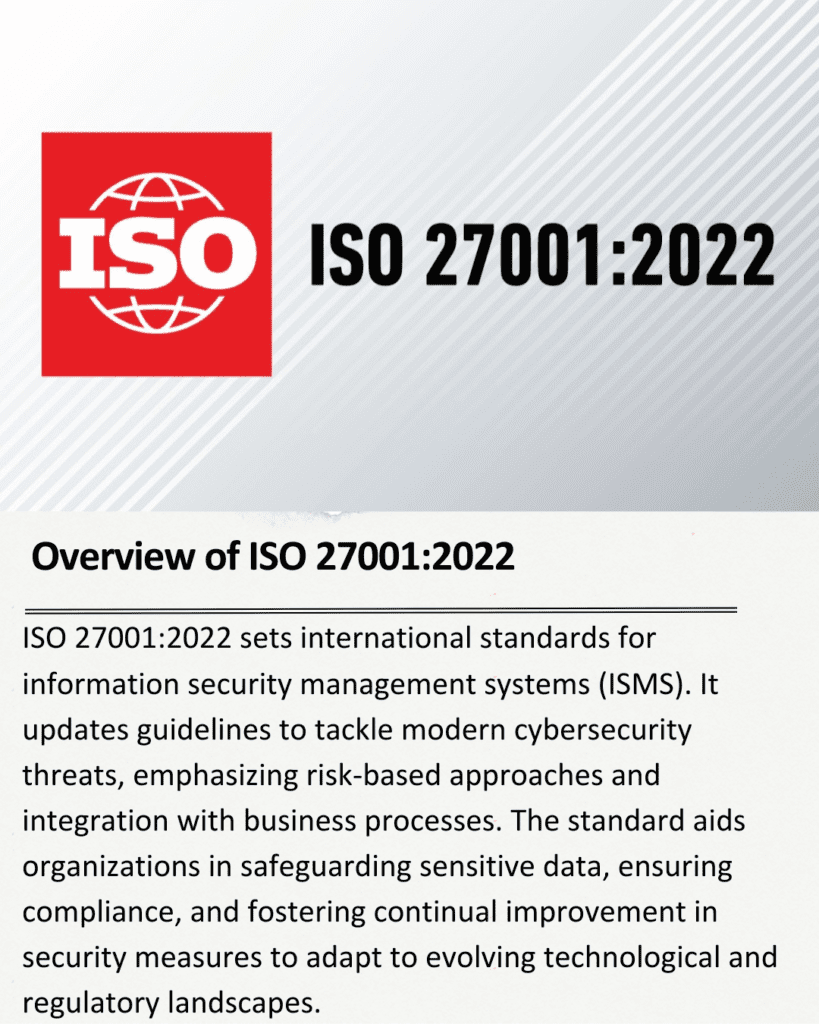ISO 27001:2022, the latest iteration of the international standard for Information Security Management Systems (ISMS), represents a significant evolution in cybersecurity practices and organizational resilience. This comprehensive introduction explores the key aspects, updates, and implications of ISO 27001:2022.
Introduction to ISO 27001
ISO 27001 sets out the requirements for establishing, implementing, maintaining, and continually improving an ISMS within the context of an organization. Its primary objective is to help organizations manage their information security risks effectively, ensuring the confidentiality, integrity, and availability of information assets.
Key Changes in ISO 27001:2022
ISO 27001:2022 introduces several notable changes aimed at enhancing its relevance and effectiveness in today’s digital landscape:
- Context of the Organization: Emphasizes understanding the organization and its context, including the needs and expectations of interested parties, to better align information security objectives with overall business goals.
- Leadership and Commitment: Requires stronger leadership involvement and commitment to information security from top management, ensuring that policies and objectives are aligned with strategic direction.
- Risk Assessment: Places greater emphasis on risk assessment methodologies, encouraging organizations to adopt a more comprehensive approach to identifying, analyzing, evaluating, and treating information security risks.
- Supply Chain Security: Introduces requirements for managing information security risks associated with suppliers, contractors, and third parties, reflecting the interconnected nature of modern business operations.
- Cybersecurity Controls: Updates and refines the controls framework to address emerging cybersecurity threats and vulnerabilities, including advancements in technology and changes in the threat landscape.
- Performance Evaluation: Enhances the evaluation of ISMS performance through monitoring, measurement, analysis, and evaluation activities, ensuring continual improvement and adaptation to changing circumstances.
Implementing ISO 27001:2022
Implementing ISO 27001:2022 involves several key steps:
- Initiation: Commitment from top management to initiate the implementation process, including establishing roles and responsibilities for information security management.
- Gap Analysis: Conducting a thorough gap analysis to assess current information security practices against the requirements of ISO 27001:2022, identifying areas for improvement.
- Risk Assessment: Performing a detailed risk assessment to identify and prioritize information security risks, considering the organization’s context, objectives, and the needs of stakeholders.
- ISMS Design: Designing and implementing an ISMS that aligns with ISO 27001:2022 requirements, including developing policies, procedures, and controls tailored to the organization’s specific risks and operational environment.
- Training and Awareness: Providing training and awareness programs to ensure that personnel understand their roles and responsibilities in maintaining information security and complying with ISMS requirements.
- Monitoring and Review: Continuously monitoring and reviewing the effectiveness of the ISMS through internal audits, management reviews, and performance evaluations.
- Certification: Seeking certification from accredited certification bodies to demonstrate conformity with ISO 27001:2022, which involves undergoing an external audit process.
Benefits of ISO 27001:2022 Certification
Achieving ISO 27001:2022 certification offers numerous benefits to organizations, including:
- Enhanced Information Security: Strengthening the protection of confidential information and reducing the risk of data breaches and cyber attacks.
- Improved Business Continuity: Enhancing resilience against disruptions and ensuring the continuity of critical business operations.
- Regulatory Compliance: Facilitating compliance with legal and regulatory requirements related to information security and data protection.
- Enhanced Reputation: Building trust and credibility with stakeholders, including customers, partners, and regulatory authorities.
- Cost Savings: Reducing costs associated with security incidents and breaches through proactive risk management and mitigation.
Future Trends in Information Security and ISO 27001:2022
Looking ahead, ISO 27001:2022 is poised to evolve in response to emerging trends in information security, such as:
- Artificial Intelligence and Machine Learning: Integration of AI-driven tools for threat detection, anomaly detection, and predictive analytics to enhance proactive security measures.
- Blockchain Technology: Leveraging blockchain for secure transactions, decentralized identity management, and enhanced data integrity and transparency.
- Data Privacy Regulations: Adapting ISMS frameworks to comply with evolving data privacy regulations, such as GDPR and CCPA, and ensuring robust protection of personal data.
- Cloud Security: Addressing unique challenges and opportunities associated with cloud computing, including data sovereignty, shared responsibility models, and integration with hybrid environments.
- IoT Security: Developing specific controls and guidelines to manage the security risks posed by the proliferation of Internet of Things (IoT) devices and ecosystems.
Conclusion
ISO 27001:2022 represents a forward-thinking approach to information security management, emphasizing risk-based decision-making, continuous improvement, and adaptation to technological advancements and regulatory requirements. By implementing and certifying against ISO 27001:2022, organizations can enhance their resilience against cyber threats, safeguard their information assets, and demonstrate their commitment to robust information security practices in an increasingly interconnected world.
